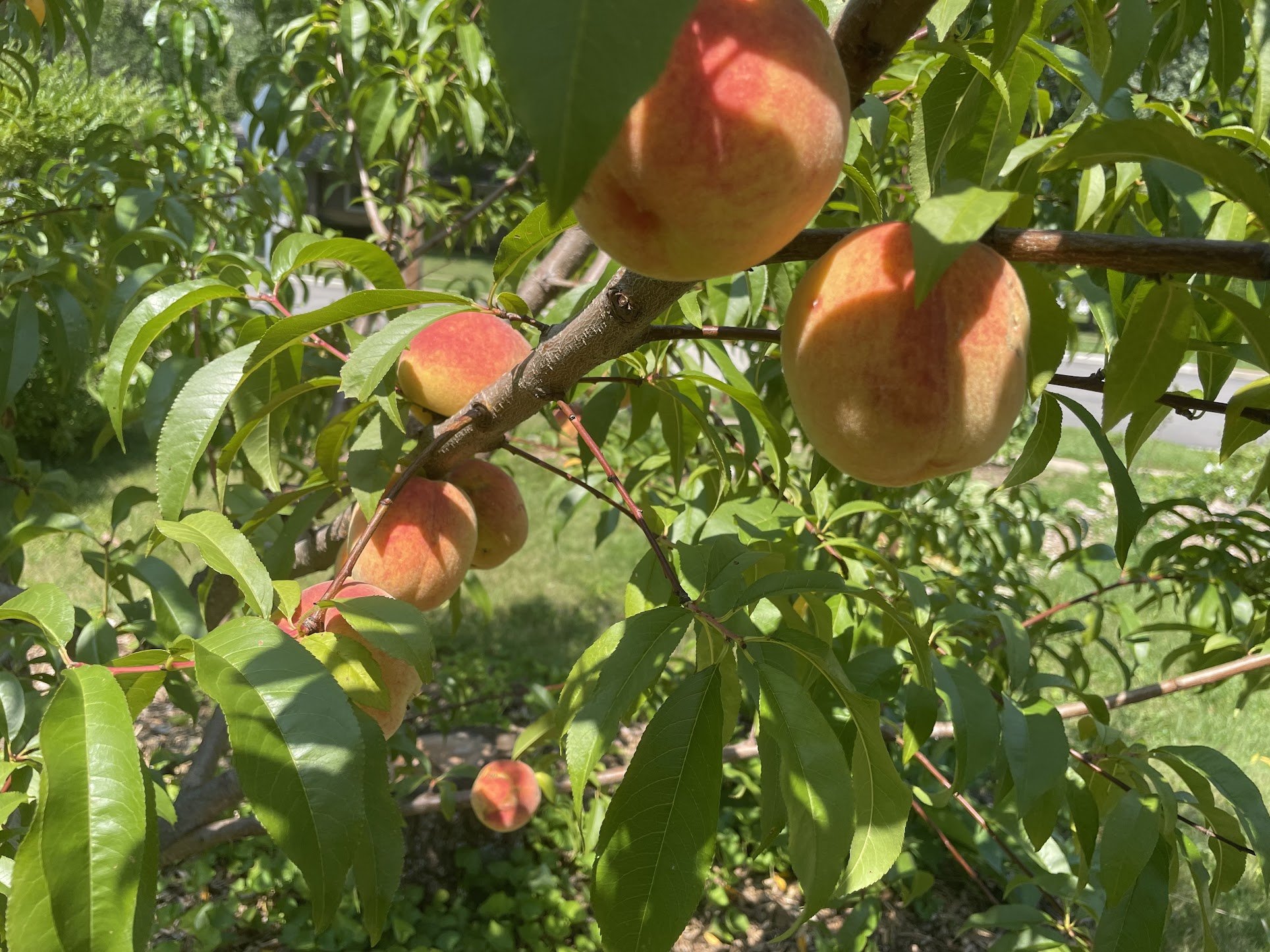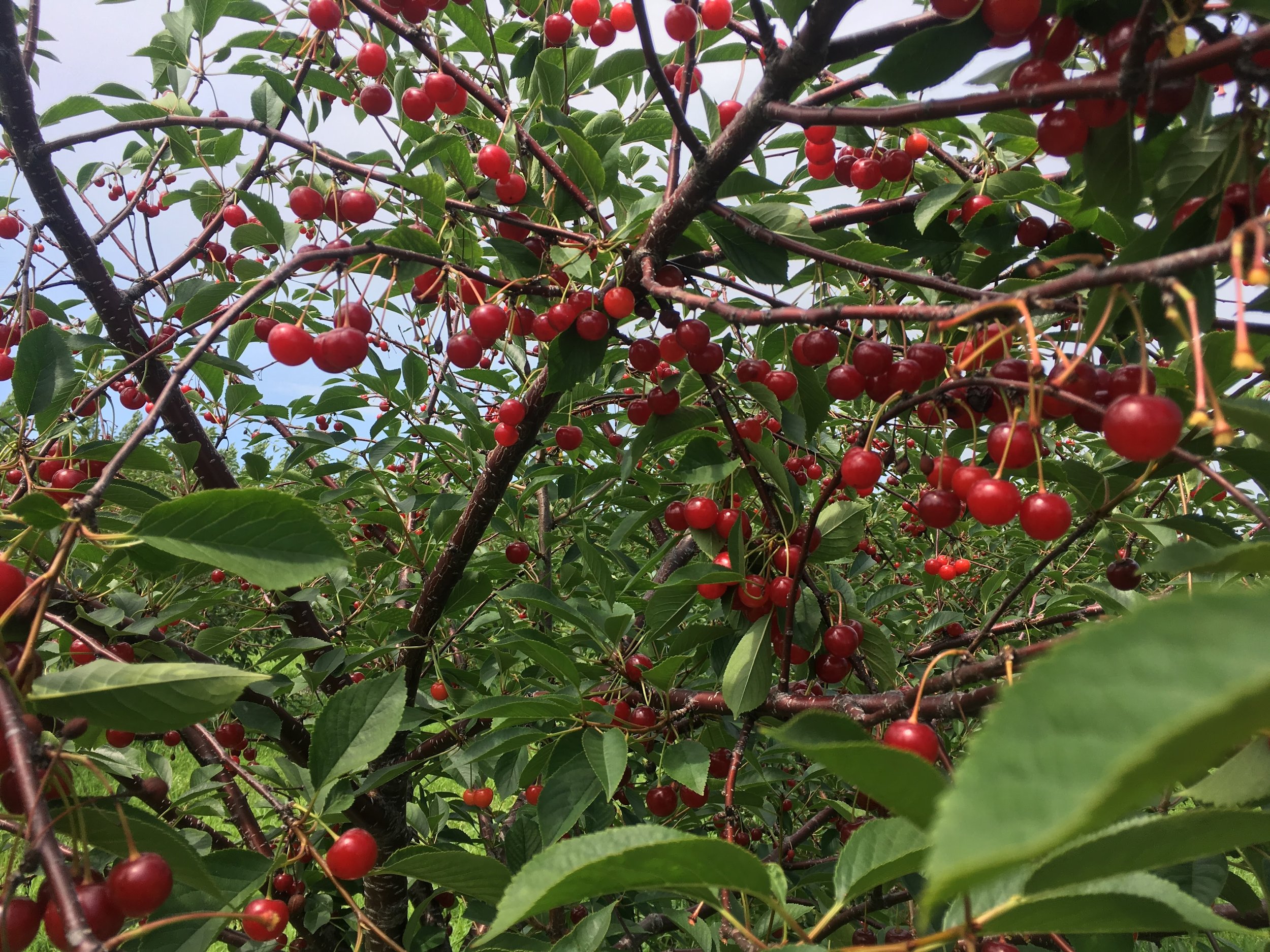To let your garden feed you is a pleasure. And it’s a pleasure many of us want to bring into our lives. Fruit carries a lot with it: health, history, and enjoyment. Humans cultivated apples not just for sustenance, but because we loved them.
Like most things in life, the reality of growing fruit is messier than our idea of it- wasps get into the grapes, rust spores splotch pear leaves, apple trees become tangled and wormy. But messy things are usually worthwhile. And there are some fruit trees and shrubs that make themselves easier for us to enjoy than others.
Here are five favorites for Madison, Wisconsin:
5. Currants (ribes)
Currants would be my number one choice, except for the fact that the shrubs aren’t particularly beautiful* and not everyone likes this fruit. Tthe red, pink, and white varieties are quite tart, and the black varieties usually have a musky taste before they’re cooked (my young neighbor describes them as “dogfood-y”). That being said, I love them all, and the neighborhood kids usually strip my red and pink bushes bare before I can get more than a bowlful.
Red, pink, and white currants look like jewels and are great with creamy things. Norwegians eat them with vanilla custard, and there’s nothing better on top of a cheesecake. Black currants are less jewel-like but incredibly nutritious and make some of the easiest and best jam (there’s plenty of pectin and acid in the berries). I can never have enough black currants. All these varieties are easy to grow, easy to maintain, small in stature, and resistant to pests.
I should also mention that currants, especially black currants, can be hosts for white pine blister rust, which won’t hurt your fruit, but can be detrimental to white pines. The good news is, there’s a lot of work being done to breed resistant varieties. If you have pines closeby, be sure to choose resistant black currant varieties like Minaj Smyriou, Chernaya Lisovenko, and Titania.
*There is an American black currant variety called Crandall that’s really quite lovely and has yellow clove-scented flowers in early spring. I should also mention that the black currant Chernaya Lisovenko has nice autumn color.
Some recommended varieties: Crandall is very good (see above), and Blackdown is my favorite European black currant for fresh eating (all black currants are delicious cooked). The pinks, reds, and whites varieties all taste like the others of their color to me. I like having one of each, but if I could only have one, it would be a red currant. They’re the tartest but the prettiest.
4. Juneberries (amelanchier)
Juneberry fruits are easy to love. They are juicy, and they are sweet, and they are purple. They grow on beautiful small trees/large shrubs that have wedding-like spring blossoms and brilliant fall foliage. Unlike mulberries, they don’t stain the sidewalk or your fingers. The only downside is they can be a bit rust prone, and I have never (not once) been able to get my fill of them. Because they’re so tasty, it’s not a fruit one gets a surplus from for baking and sharing (when I find a particularly delicious roadside tree, I keep quiet about it.)
Some recommended varieties: I haven’t met a juneberry I don’t like. Just find one that’s the right size and don’t let the rabbits eat too many of the branches in winter.
3. Peaches
This choice is a bit self-indulgent, because unsprayed home-grown peaches in Madison, Wisconsin are rarely blemishless. The branches like to be pruned yearly, the flowers can get nipped by late frosts, and the trees have a reputation for being short-lived (full sized pear trees regularly live past one hundred, peaches often just reach fifteen).
That being said, they grow quickly, bear fruit young, don’t have a lot of serious pest/disease issues, and are really quite charming trees with willowy branches and leaves that turn bright yellow in October. But the thing that matters is the peaches. Until I grew them myself, I had never tasted a tree-ripened peach (ripe peaches are very delicate, so they are always picked and shipped unripe.) This year, my three-year-old tree gave us enough peaches to eat our fill, bake a pie, and send a few home with friends. I wouldn’t want to be without one.
Some recommended varieties: In zone 4/5 Wisconsin, our options are limited, but Contender, Redhaven, and Reliance are all great choices and have sweet pink flowers. Peach trees are self-pollinating, so you only need one.
2. Pie Cherries
I learn a lot about gardening by watching kids, and kids like eating pie cherries from the tree. Incidentally, squirrels do too, and so do I, so I haven’t had a chance to make any pies or preserves. But the fruit and trees and both so good and problem-free, my answer has been to plant more of them- I have more of these trees in my yard than any other.
Sometimes called “sour cherries,” they aren’t really very sour if you wait until they’re fully ripe to pick them, and they are much easier to grow than sweet cherries. Plenty of dwarf varieties are available and most all are self-pollinating, so they are ideal fruit trees for small yards. As a bonus, some have lovely spring flowers, and unlike peaches, which always seem youthful, cherry trees show character early.
Some recommended varieties: North Star is a great natural dwarf with dark red juice and Mesabi has a reputation for sweetness. Still, the classic Montemorecy cherry is hard to beat.
1. Pears
If you want fruit fast, don’t plant a pear. They have a reputation for taking a long time to bear. There’s a saying “pears are for heirs,” and for some varieties, the wait for fruit can be up to a decade (there are some exceptions- like Harrow Sweet, which usually starts flowering in the first couple years).
But pears are also for heirs because of their longevity. It’s nice to plant something knowing that it can be enjoyed by your grandkids. In the meantime, pears aren’t so picky about the care they get. They have less disease/insect pressure than apples, and their form is nice even when they aren’t pruned.
Besides all that, the incredible yield from a mature pear tree affords you the opportunity to be really generous. You can give everyone you know a paper shopping bag full and still have plenty.
I think there’s nothing better than that kind of abundance, but one thing to be aware of is that pears (depending on the variety) are often ready to be picked all at once, and if they sit on the tree too long, they can rot from the inside. This can be difficult, but it can also allow you to handle the glut all in one weekend. And what’s better than dried pears?
Some recommended varieties: Harrow Sweet is not only precocious, but also disease resistant and incredibly good. Cabot is self-fertile and supposedly has lovely double flowers (mine hasn’t bloomed yet.) Seckel is sweet, reliable, and well-loved. An important thing to remember about pears is that most need a partner for pollination, so plant two. Bees and other pollinators aren’t as attracted to their flowers as some other blossoms, so it’s a good idea to plant them within 50 feet of each other to increase the chances of good fruiting.
Of course, growing your own fruit is not sensible- pleasure rarely is. If what you really want is to grow European prune plums, figs in pots that you move into the house for winter, or a giant apple tree that’s impossible to gather fruit from (but wonderful to climb), that’s what you should do. The joy of gardening is in playing and noticing and doing what you like.



